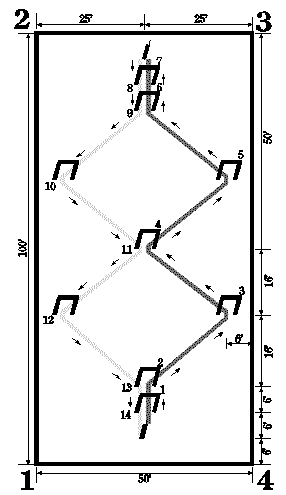
BACKYARD CROQUET RULES
for the traditional 9-wicket court setting
- This page summarizes the USCA's new rules for Backyard Croquet, recommended for play on the traditional double-diamond, two-stake court setting. For the Blake croquet court, we are using the "advanced rules" (which means that deadness carries over from your previous turn and that a ball may roquet any other ball on which it is alive). These rules can be amended when the skill level of the players calls for a more relaxed game.
BASIC RULES FOR NINE-WICKET CROQUET

- Game Overview
- The standard double-diamond rectangular court (shown at right) officially
measuring 50' wide and 100 feet long, may be reduced to fit the size and
shape of the space available. The Blake court is scaled proportioinately
for a length of 70'.
The game is designed for up to six balls, and may be played with any number of players from two to six. There are always either four balls (two on each side) or six balls (three on each side). (It is possible, however, to play a version of 9-wicket in which it's "each person for himself/herself" -- sometimes called cut-throat, this game follows all the rules specified here; the winner is the first person to stake out.)A game usually requires from one to two hours to play to its conclusion - that is, until one of the players or teams has "staked out" by scoring all the wickets and striking the Finishing Stake with all the balls on its side.
- The Sides
- There are always only two sides,with the "hot colors" (red/yellow/orange) competing against the "cool colors" (blue/black/green). When only four balls are played, the sides are blueblack against redyellow.
- The Players
- When the number of players equals the number of balls on a side, each
player plays only one ball throughout the game. When the number of players
does not equal the number of balls on a side, the players on that side
alternate turns and may play any one ball on their side in a turn. Team
captains may be chosen, and players may confer to decide which ball should
be played in each turn.
- With two players, each of them plays all the balls on a side.
- Starting The Game
- A coin-toss gives the winning side the choice of playing first or second.
Each of the balls must be brought into play in the first round of turns,
in the order of the colors on the stake: blue/red/black/yellow/green/orange.
The starting "tee" is one mallet-length in front of Wicket #1.
- The Turn
- A turn consists of one stroke plus any additional bonus strokes earned by the ball in play. At the conclusion of a turn in which a wicket or stake point is scored, the wicket clip of the color corresponding to the ball should be placed on the next wicket or stake to be scored by that ball. (If your set does not include wicket clips, you may use colored clothespins.) The balls must be played in strict sequence throughout the game: Blue/Red/Black/Yellow. If only one ball of a side has hit the Finishing Stake and is out of the game, that side loses the turn of the staked-out ball, and play continues in the proper sequence to the end of the game.
- Bonus Strokes
- There are two ways to earn bonus strokes: by scoring wicket and stake
points or by hitting (also called "roqueting") an opponent's
ball with the ball in play.
- Wicket or Stake Bonus Stroke
- One bonus stroke is earned for passing through your proper wicket in
the order of the course. One bonus stroke is earned for striking the Turning
Stake after scoring Wicket #7. These strokes must be played from where
the ball lies after the point is made. No bonus stroke is earned by a ball
that "pegs out" by striking the Finishing Stake.
- Roquet Bonus Strokes
- You get two bonus strokes when your ball hits (or roquets) a ball of
the other side.
- The Croquet Stroke is the first of these, played either in contact with the roqueted ball or from one mallet-head's distance, The contact Croquet Stroke is played by placing your ball in contact with the ball you hit (roqueted) and striking your ball to make both your ball (the striker's ball) and the other ball (the croqueted ball) move. "Stopping" your ball by placing a foot on it to keep it from moving is NOT allowed in this version of the game.
- The Continuation Stroke is the second of the two roquet bonus strokes, and it is played from wherever the striker's ball lies after the Croquet Stroke.
- Deadness. A ball is "dead" on a ball it roquets for bonus strokes and does not become "alive" again on that ball (that is, eligible to hit it again for bonus strokes) until the striker scores a wicket or stake. A rover ball may become "alive" by going through any wicket in any direction, but may roquet the other balls no more than once in a turn. Once you've roqueted a ball, you are said to be "dead" on that ball. In the four-ball game, it is possible to accumulate deadness on one, two or three balls. This is not a desirable condition, for it seriously limits your options. If you hit a ball that you're dead on, all balls return to their original positions and the turn ends.
Bonus strokes may not be accumulated: Only the last-earned bonus stroke(s) may be played. On the Croquet Stroke, if the striker's ball clears a wicket, the Continuation Bonus Stroke is lost, and only the Wicket Bonus Sroke may be the played. On the Croquet Stroke, if the striker's ball roquets another ball on which it is entitled to take bonus strokes, the Continuation Stroke from the first roquet is lost, and you are entitled only to the two newly earned bonus strokes.
If your ball clears a wicket and in the same stroke hits an opponent ball on the other side of the wicket, the hit does not count as a roquet; you may, however, choose to then roquet the opponent ball with your Wicket Bonus Stroke.
There is one exception to the rule against accumulating bonus strokes: You may earn two bonus strokes by scoring two wickets in one stroke. (This commonly occurs at the Starting Stake and the Turning Stake, when you may score both wickets in one stroke so you can use the two consecutive bonus strokes earned to attack the position of the other side(s).
If another player sends your ball through its proper wicket (or into its stake), your ball does score the point; however, there is no bonus stroke. Bonus strokes may be earned only by the ball in play during its own turn.
- Rover Balls
- Rovers are balls which have completed all the course except for striking the Finishing Stake. Rovers may be staked out - that is, driven into the Finishing Stake - with any legal stroke by any player at any point in the game.
- Winning the Game
- The side which scores all the wickets and strikes the Finishing Stake with all its balls wins the game. In timed games, the side with the most points wins when time is called; each wicket or stake scored by each ball counts for a point. If there is a tie, keep playing until one side scores a point and thus wins the game.
- Boundaries
- Boundaries designated by a string or special markings should be at least 6 feet beyond the outer wickets and stakes.
- Boundary Balls: Novice
- The "boundary" rules depend on the level of players and will be specified before each game. For games involving novices, all balls sent out of bounds are brought to the point where they crossed the designated Boundary and placed one mallet-length inside the court before play resumes. There is no penalty or loss of strokes for sending any ball out of bounds. Out-of-bounds balls are simply placed in bounds, and play resumes. All balls that come to rest within the Boundary Margin - closer than a mallet-length to the Boundary - are immediately replaced on the Boundary Margin, with the one exception of the striker's ball still in play on a Continuation Stroke or a Wicket Bonus Stroke, which is played from from wherever it lies within the Boundary Margin.
- Boundary Balls: Advanced Players
- For games involving advanced players, all balls sent out of bounds are brought to the point where they crossed the designated Boundary and placed one mallet-length inside the court; the stroker's turn ends at that point. If on a roquet shot you knock the roqueted ball out of bounds, it is brought one mallet's length in from the boundary and your ball remains where it stopped; you receive no bonus points when you roquet a ball out of bounds.
- Faults and Penalties
- You must strike the ball only with the face of the mallet. The mallet
may not touch any other ball except the striker's, nor may it strike a
wicket or stake, nor may it "crush" a ball against a wicket or
stake to make the stake or wicket bend or move.
There are no penalties for faults. Out-of-turn plays and all faults should be corrected by replacing the balls to their positions before the fault occurred and replaying the shots correctly.Unless there is a previously appointed referee, the word of the striker should be accepted in disputes. In disagreements on replacement of balls to replay fouled strokes, the offending side must accept the judgment of the opponent.
These rules were modified from the version written by Bob Alman for the United States Croquet Association.